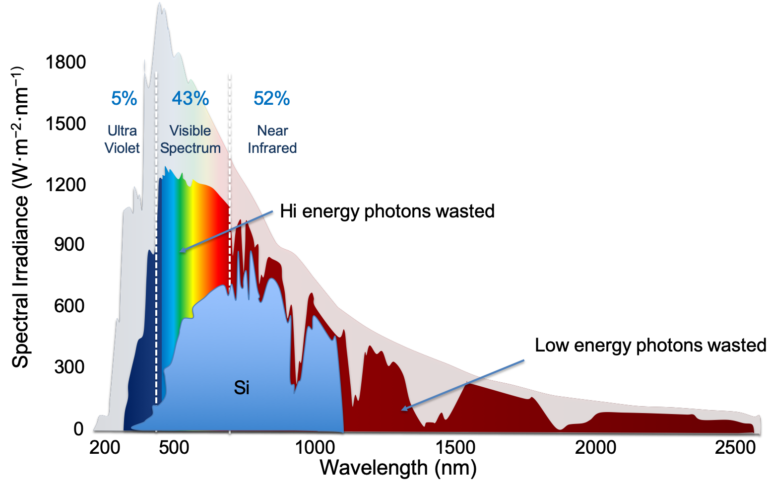Solar insolation in space

2.1 Kw Suntech 175 mono, Classic 200, Trace SW 4024 ( 15 years old but brand new out of sealed factory box Jan. 2015), Bogart Tri-metric, 460 Ah. 24 volt LiFePo4 battery bank. Plenty of Baja Sea of Cortez sunshine.
Comments
-
For our calculations, we typically use 1,000 W per sq meter.
For space:
https://en.wikipedia.org/wiki/Solar_constantThe actual direct solar irradiance at the top of the atmosphere fluctuates by about 6.9% during a year (from 1.412 kW/m2 in early January to 1.321 kW/m2 in early July) due to the Earth's varying distance from the Sun, and typically by much less than 0.1% from day to day.Remember that solar cells cannot use the "entire" spectrum, so what an actual solar panel can convert to electricity is not 100% of total actual irradiance (i.e., infra red, ultra violet, etc.).
Example:
https://www.researchgate.net/publication/258549615_A_comparison_of_silicon_and_germanium_Photovoltaic_Power_Conversion_for_power-over-fibre
https://qdsolarinc.com/technology/
The typical "best laboratory silicon panel on the the ground" is around 26.7% overall efficiency. Best commercial is something like 25%
https://www.tandfonline.com/doi/full/10.1080/23746149.2018.1548305
-Bill
Near San Francisco California: 3.5kWatt Grid Tied Solar power system+small backup genset -
Thanks Bill. I was thinking it would be higher. Aren't they typically very cold out there? I was wondering how much the hi tech satellites PV arrays get. I have seen some pretty impressive "Cloud Edge Effect" power on my array over the years and not even in frigid conditions.
2.1 Kw Suntech 175 mono, Classic 200, Trace SW 4024 ( 15 years old but brand new out of sealed factory box Jan. 2015), Bogart Tri-metric, 460 Ah. 24 volt LiFePo4 battery bank. Plenty of Baja Sea of Cortez sunshine.
-
A couple of discussion links for ISS:
https://space.stackexchange.com/questions/14256/what-is-the-temperature-of-solar-panels-used-in-space-missions-such-as-iss
https://space.stackexchange.com/questions/23013/how-are-the-silicon-pv-cells-constructed-in-the-isss-solar-panels-are-they-as
The first link says simulated panel temperatures run from -100F in eclipse to +150F in full sun.
The second link has a bit more detail on cell design and construction...
Edge of cloud effects have been described (in my humble opinion) as a lensing effect. So collection from a larger region and focusing to a a smaller area (your panel) would seem to be possible.
It seems that the photon physics of clouds are not what one would expect. Not sure "lensing" is actually the correct theory... "Glories" would seem to be an edge of object lensing effect... However, it may not be accurate:
https://science.howstuffworks.com/nature/climate-weather/atmospheric/cloud-spiral-phenomenon.htm
https://www.nature.com/articles/nature.2014.14869Optical theorists' attempts to fully understand how glories work were unsuccessful until the 1980s, when physicist Moysés Nussenzveig at the Federal University of Rio de Janeiro in Brazil showed that the main cause is a process known as wave tunnelling2,3. This is caused when rays of sunlight reflected by a droplet do not actually hit the droplet — as in the case of rainbows — but merely pass near it. They nonetheless stir up electromagnetic waves within the droplet. Those waves rattle around inside the droplet and eventually tunnel back out, sending light rays back in the direction from which they came. The way waves resonate within the droplet is wavelength-dependent, thus splitting white light into the spectrum of colours.-BillNear San Francisco California: 3.5kWatt Grid Tied Solar power system+small backup genset -
We get a lot of cool views out west of all the rocket launches from Vandenberg AFB

2.1 Kw Suntech 175 mono, Classic 200, Trace SW 4024 ( 15 years old but brand new out of sealed factory box Jan. 2015), Bogart Tri-metric, 460 Ah. 24 volt LiFePo4 battery bank. Plenty of Baja Sea of Cortez sunshine.
-
I'm really surprised to see the same type cells still being used in modern day satellite PV Here's a photo from one of the linked articles and a photo of one of my vintage panels made with the same type cells. you might need to enlarge the first photo to get a good look.


2.1 Kw Suntech 175 mono, Classic 200, Trace SW 4024 ( 15 years old but brand new out of sealed factory box Jan. 2015), Bogart Tri-metric, 460 Ah. 24 volt LiFePo4 battery bank. Plenty of Baja Sea of Cortez sunshine.
-
I saw that too...
-BillNear San Francisco California: 3.5kWatt Grid Tied Solar power system+small backup genset -
littleharbor2 said:We get a lot of cool views out west of all the rocket launches from Vandenberg AFB

I really liked watching the Vandenberg launches when I lived in Morro Bay!
I always have more questions than answers. That's the nature of life. -
Pretty good anchored out off Kennedy also. Falcon launch from there last night.
 "we go where power lines don't" Sierra Nevada mountain area
"we go where power lines don't" Sierra Nevada mountain area
htps://offgridsolar1.com/
E-mail offgridsolar@sti.net -

"we go where power lines don't" Sierra Nevada mountain area
htps://offgridsolar1.com/
E-mail offgridsolar@sti.net
Categories
- All Categories
- 233 Forum & Website
- 141 Solar Forum News and Announcements
- 1.4K Solar News, Reviews, & Product Announcements
- 199 Solar Information links & sources, event announcements
- 900 Solar Product Reviews & Opinions
- 256 Solar Skeptics, Hype, & Scams Corner
- 22.5K Solar Electric Power, Wind Power & Balance of System
- 3.5K General Solar Power Topics
- 6.7K Solar Beginners Corner
- 1K PV Installers Forum - NEC, Wiring, Installation
- 2.1K Advanced Solar Electric Technical Forum
- 5.6K Off Grid Solar & Battery Systems
- 429 Caravan, Recreational Vehicle, and Marine Power Systems
- 1.1K Grid Tie and Grid Interactive Systems
- 656 Solar Water Pumping
- 816 Wind Power Generation
- 624 Energy Use & Conservation
- 623 Discussion Forums/Café
- 315 In the Weeds--Member's Choice
- 75 Construction
- 125 New Battery Technologies
- 108 Old Battery Tech Discussions
- 3.8K Solar News - Automatic Feed
- 3.8K Solar Energy News RSS Feed
